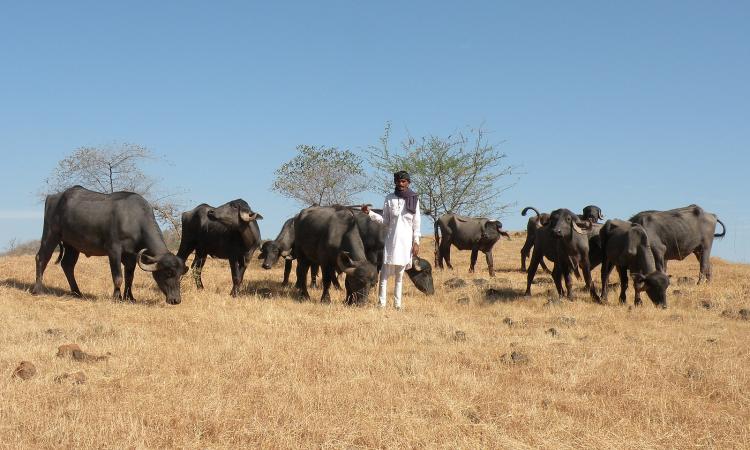
India's first round the clock solar power plant in Modhera village Gujarat, threatens livelihoods of pastoralists
A six-megawatt ground mounted solar power plant, which powers the village of Modhera and constructed on an area designated as common grazing land, has met with stiff opposition from the locals. Pastoralists from the neighbouring village of Sujanpura, who depend on the grasslands to feed their livestock are now having to spend Rs 200-Rs 300 a day to buy hay for their livestock, which was earlier freely available in the commons.
This has brought to the forefront the issue of land, forest and community rights conflicts around renewable energy projects that are becoming increasingly common in India which have no regulatory frameworks and lack social or environmental impact assessments, thus leading to violations of people’s land rights. (Scroll).
Community participation helps Maharashtra village become flood free
The village of Kondgaon-Sakharpa in Maharashtra faced regular flooding due to the wrath of the river Kajli. This was because the riverine flows of the Kajli had been restricted and diverted over the years and made to pass through narrow culverts or diversion channels. The debris accumulated in the pools of the river from infrastructure projects like roads, railways, dams and hydroelectric power plants had made the river shallow, leading to flooding during the monsoons.
The residents of Kondgaon-Sakharpa formed the Kajli River Conservation Committee (KRCC), with technical support from water conservationists and NGOs, to restore the river. Land was raised on both sides of the river for up to a kilometre and the debris was removed from the riverbed with the help of earthmovers, which stopped the river from flooding during the monsoons.
In 2021, the people’s organisation worked to raise the land on both sides of Kajli and the debris was removed from the riverbed. The residents have survived two monsoons after the restoration, without floods. (Mongabay, India)
Floods, erratic rains, infrastructure growth shift farming practices in Assam's Dhemaji district
Local population of the Mising tribe who have agriculture as their primary occupation, have coexisted with floods for years. But the floods are now getting worse, with erratic rainfall and construction debris from roads, highways and bridges getting deposited in rivers and farmlands, impacting farming in the area and reducing farm output due to deposition of sand.
Farmers are now trying to now cope by shifting their cropping patterns, and cultivating more Rabi (winter) crops, such as mustard, potatoes and peas, that are sown in November, rather than Kharif crops, such as rice, sown in June and July. Others are giving up farming, preferring instead to migrate to nearby cities and towns for jobs. (Indiaspend)
Natural farming helps a Madhya Pradesh villages cope with climate change effects
Farmers from 60 villages in three districts of Madhya Pradesh were encouraged to adopt natural farming methods through the ‘Climate-Smart Villages’ project, initiated by the state government. The project focused on teaching farmers innovative methods of natural farming and reducing the emission of greenhouse gasses emerging from agricultural activities. It also aimed to reduce the risk and impact of climate change with measures such as soil and water conservation and the cultivation of drought and flood-tolerant seeds.
The farmers adopted techniques such as digging ponds in the fields, direct seeding of paddy, cultivating pulses and soybeans in raised beds, composting instead of stubble burning, sowing drought-tolerant seeds and using natural pesticides, that helped improve the soil quality and yield.
Climate-smart farming practices led to an increase in organic carbon and dehydrogenase activity in the soil by an average of 10.7 percent to 11.55 percent. There was a significant improvement in crop quality and the production increased by 10 to 20 percent (Mongabay, India).
Sacred groves help resurrect a near extinct forest system in Tamil Nadu
Trees planted in Auroville Botanical Garden in Tamil Nadu, located within 30 to 50 kilometers of the Coromandel Coast included drought resistant species in the early phases that were largely unsuited for the cyclone-prone tropical coast. A large team of Auroville-based foresters and botanists began exploring sacred groves and realised that the sacred groves supported a rich biodeiversity with flora and fauna that suited the climate in the region.
The team mapped the tropical dry evergreen forest sites in the region and documented their biodiversity, then collected seeds and started nurseries to restore native forests in the region. The tree composition of the forest has now started to change with plantation of native species.
Today, community-run nurseries supply around 50,000 saplings a year for tree-planting projects in Auroville, and local residents have planted native species across the almost 500 hectares of green space that includes community-owned and collectively managed forests (Hakai magazine)
This is a roundup of important news updates from the 1st March to 15th March 2023. Also read our policy roundups here
Lead image source can be found here
/articles/indias-first-round-clock-solar-village-angers-pastoralists